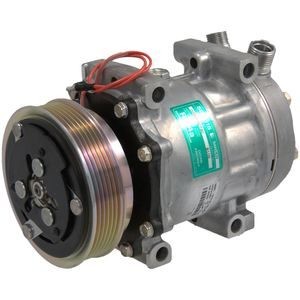When your car’s air conditioning system starts blowing warm air, especially on a scorching summer day, the thought of repair costs can be daunting. One of the most crucial components of your AC system is the compressor. But how much does it actually cost to repair or replace your car’s AC compressor? This guide will break down the costs, factors that influence pricing, and help you understand your options for getting your AC blowing cold again.
Understanding the AC Compressor and its Function
The AC compressor is the heart of your vehicle’s air conditioning system. Think of it as a pump that circulates refrigerant throughout the system. Powered by the engine’s drive belt, the compressor takes in low-pressure refrigerant gas, compresses it into a high-pressure, high-temperature gas, and then sends it through the rest of the AC system. This process is essential for cooling the refrigerant and ultimately providing cool air inside your car.
Car AC compressor unit, a key component in vehicle climate control systems.
Inside the compressor, various parts can fail over time. A common culprit is the compressor clutch, which engages and disengages the compressor as needed. Bearings within the clutch can also wear out, leading to noise. Other issues include internal leaks from bad seals or general wear and tear of the mechanical components.
Signs of a Failing AC Compressor
A malfunctioning AC compressor often manifests in noticeable ways. The most obvious sign is warm air blowing from your vents when you expect cold air. However, other symptoms can indicate compressor problems:
- No cold air: This is the primary symptom. If your AC is blowing warm or only slightly cool air, the compressor might be failing to properly circulate refrigerant.
- Unusual noises: Listen for loud squealing, grinding, or knocking sounds coming from the engine compartment when the AC is turned on. These noises could indicate a worn compressor clutch or internal damage.
- Clutch problems: If you notice the compressor clutch clicking on and off rapidly or not engaging at all, it could be a sign of a faulty clutch or an issue within the compressor itself.
- Refrigerant leaks: While not always directly from the compressor, leaks in the system, potentially caused by compressor seal failure, can lead to insufficient refrigerant and poor cooling.
It’s crucial to remember that a lack of cold air could stem from various AC system issues, not just the compressor. Low refrigerant, a faulty relay, or a bad cycling switch can also cause similar symptoms. Therefore, proper diagnosis is essential before assuming the compressor is the problem.
Factors Influencing AC Compressor Repair Costs
The cost to repair or replace an AC compressor can vary significantly based on several factors:
- Vehicle Make and Model: Luxury vehicles or those with complex AC systems often have more expensive parts and potentially higher labor costs. The location and accessibility of the compressor in the engine bay can also affect labor time.
- Type of Compressor: New compressors are generally more expensive than remanufactured or used ones. While remanufactured compressors can be a cost-effective option, ensure they come with a warranty. Used compressors are the cheapest but carry the highest risk of failure and typically lack any warranty.
- Labor Costs: Labor rates vary widely depending on your location and the repair shop. Dealerships usually have higher labor rates compared to independent mechanics or chain auto repair shops.
- Additional Parts and Services: As the original article mentions, replacing the compressor often necessitates replacing other components like the accumulator or receiver drier, orifice tube, and seals. Furthermore, a system flush is crucial, especially if the old compressor failed internally, to remove debris and contaminants that could damage the new compressor. Refrigerant recharge is also a necessary part of the service.
DIY vs. Professional AC Compressor Repair Costs
You have two main options when it comes to AC compressor repair: DIY or professional service. Each has its own cost considerations.
DIY AC Compressor Repair Cost Breakdown
Opting for DIY can save you significantly on labor costs. However, it requires mechanical aptitude, specialized tools, and careful attention to detail. Here’s a breakdown of potential DIY costs:
- Compressor: $200 – $500+ (depending on new, remanufactured, and vehicle type)
- Accumulator/Receiver Drier: $50 – $150
- Orifice Tube/Expansion Valve: $10 – $50
- Seals and Gaskets: $20 – $50
- Refrigerant: $30 – $100+ (depending on refrigerant type and amount needed)
- AC System Flush: $20 – $50 (flush chemicals)
- Vacuum Pump Rental: $30 – $50 (rental fee)
- Manifold Gauge Set Rental/Purchase: $50 – $200+ (rental fee or purchase price)
- Miscellaneous (oil, cleaners, etc.): $20 – $50
Total DIY Cost: Roughly $430 – $1100+
Keep in mind that DIY AC work involves handling refrigerant, which requires proper disposal methods and potentially specialized knowledge. Improper handling can be harmful to the environment and your AC system. Furthermore, accurately diagnosing the issue and performing the repair correctly is crucial to avoid further problems. This option is best suited for experienced DIYers with a good understanding of automotive AC systems.
Professional AC Compressor Repair Cost Breakdown
Having a professional mechanic handle your AC compressor repair offers convenience and expertise. However, it comes at a higher cost due to labor charges. Here’s an estimated breakdown:
- Compressor (parts and markup): $300 – $800+
- Accumulator/Receiver Drier (parts and markup): $75 – $200
- Orifice Tube/Expansion Valve (parts and markup): $20 – $75
- Seals and Gaskets (parts and markup): $30 – $75
- Refrigerant and System Flush: $100 – $250
- Labor (5-8 hours at $75-$150/hour): $375 – $1200
Total Professional Repair Cost: Roughly $900 – $2600+
Car AC accumulator, an essential component often replaced with the compressor.
As you can see, professional AC compressor replacement can easily range from $750 to $1500, and potentially even higher depending on your vehicle and location. Obtaining quotes from multiple shops is always recommended to compare pricing and services.
Essential Parts to Replace with the Compressor
When replacing your AC compressor, it’s strongly recommended to replace certain other components simultaneously to ensure a long-lasting and reliable repair. These typically include:
- Accumulator or Receiver Drier: This component filters moisture and debris from the refrigerant. It’s crucial to replace it as it can become saturated and compromise the new compressor.
- Orifice Tube or Expansion Valve: These components regulate refrigerant flow. They are relatively inexpensive and should be replaced to prevent potential clogging and ensure proper system function.
- Seals and O-rings: Replacing all seals and O-rings when disconnecting AC lines is essential to prevent refrigerant leaks.
AC receiver drier, another critical part recommended for replacement during compressor service.
Skipping these replacements to save money initially can lead to premature failure of the new compressor and additional repair costs down the line.
Extending Your AC Compressor Lifespan
While AC compressors aren’t considered regular maintenance items, you can take steps to potentially extend their lifespan:
- Regular AC Use: Using your AC periodically, even in cooler months, helps circulate refrigerant and lubricant, keeping seals pliable and preventing internal components from drying out.
- Proper System Maintenance: Addressing refrigerant leaks promptly and ensuring the system is properly charged can reduce stress on the compressor.
- Scheduled Inspections: Having your AC system inspected periodically by a professional can identify potential issues early on before they escalate into major compressor problems.
AC orifice tube, a small but important component in refrigerant regulation.
Generally, an AC compressor can last for 10-12 years or 150,000 to 200,000 miles. However, lifespan can vary depending on usage, climate, and maintenance.
Driving with a Faulty AC Compressor: Safety Considerations
In most cases, driving with a bad AC compressor is safe from a mechanical standpoint. Your car will still operate normally, albeit without cold air. However, there are situations where it’s best to avoid driving:
- Noisy or Seized Compressor Clutch/Pulley: If you hear loud grinding, squealing, or knocking noises from the compressor area, or if you notice the pulley wobbling or seizing, it could indicate a failing clutch bearing. In these scenarios, the serpentine belt could be damaged or break, potentially leaving you stranded and causing other engine issues.
- Belt Damage Risk: A failing compressor pulley can put excessive stress on the serpentine belt, leading to premature wear or breakage.
If you suspect a problem with the compressor clutch or pulley, inspect it visually and listen for unusual noises. If there’s any doubt, it’s best to have your vehicle inspected by a mechanic before driving extensively.
Conclusion
Repairing or replacing your car’s AC compressor can be a significant expense. Understanding the factors influencing cost, your DIY versus professional options, and the importance of proper diagnosis and component replacement will help you make informed decisions. While DIY can save on labor, professional service offers expertise and convenience. Ultimately, getting your AC system properly repaired will ensure your comfort and potentially prevent further, more costly issues down the road. For a precise estimate tailored to your vehicle, it’s always best to consult with a trusted local mechanic.


